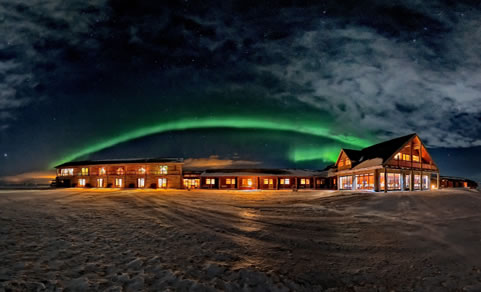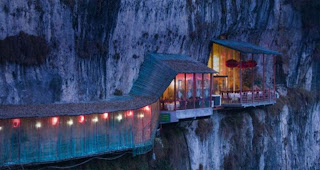
We
live in a world blessed with sights that are beautiful beyond words.
Every human being probably dreams of visiting at least one of those
places in their lifetime. Living in modern cities with high-rise
buildings, we tend to miss out on what Mother Nature has to offer as
well as some of the most incredible man-made structures built throughout
the course of history. Here's the most beautiful places in the world to
spend your holiday.
Blue Lagoon, Iceland
This place is filled with many
artificial ponds containing material of volcanic activity. With
mineral-rich water contained herein is believed to have the power to
cure certain diseases. In winter, hot steam emerging from the pond
surrounded by snow and ice, thus creating a tense atmosphere.
Haleakala, Hawaii
Haleakala, this area surrounds
the Maui volcano, Hawaii. Every year nearly more than 1.5 million people
visit Haleakala. They sometimes just want to watch the sun rise or set,
with the charm of a very dramatic, also witnessed a large group of
Haleakala crater. Haleakala name comes from the Hawaiian language, which
means house of the sun. According to legend, the demigod of Maui has
kept the sun in this place to extend the time of day.
Chocolate Hills, Philippines
Chalk hill Chocolate Hills area
of 20 square miles located on the island of collapse, the Philippines,
which covered almost 1300 lawn. This limestone hill altitude of about
100 to 400 feet. When the dry season, this mountain resembles a giant
chocolate chip. Based on local legend, this hill is formed of a giant
buffalo dung fed poisoned by local farmers. However, the scientists
concluded that the hill was formed by debris volcano.
Craters of the Moon National Park
Craters of the Moon National
Park in Idaho, an area that resembles a month you can be found in the
United States. Formed from volcanic eruption that occurred 15,000 years
ago, creating lava field covering an area of more than 600 square miles.
Strength of the eruption and then create a cone-shaped embers and lava
overdraft.
Racetrack Playa, California
Racetrack Playa in Death Valley
National Park, California USA, currently known as a mysterious stone
sled. Dry lake is paved with stone and mud sediment. No one has ever
seen the stones move. However, a growing theory that the movement is due
to strong winds and caused the glacial ice. Impact occurs during the
rainy season, a shallow lake where the surface becomes slippery.
Cappadocia, Turkey
Cappadocia in Turkey featuring
unique rock formations called "fairy chimneys despair". Cappadocia is
formed from the geology and volcanic activity, including weather and
erosion, which occurred about 60 million years of Islam. In 2000, the
Christians built the first church in the region's unique rocks.
Dead Sea, Middle East
Shores of the sea with salty
water called the Dead Sea is the lowest on earth, which is nearly 1,400
feet below sea level. The water here is saltier than the water in the
ocean, because of the high salt levels, allowing living creature can
float on water. Dead Sea waters widely used for medical therapy. This
giant lake water continues to shrink, because there are dangerous holes.
Madagascar, East Africa
On the island of Madagascar, on
the southeast coast of Africa, many forest trees have long roots here.
Trees are capable of absorbing large amounts of water and altitude of
100 feet with a diameter of nearly 400 feet.
Pamukkale, Turkey
Coral Pamukkale in Turkey,
almost resembling a frozen waterfall rather than a source of heat.
Cliffs and shallow lakes formed by volcanic activity and contains high
levels of calcium. The ancestors of the local people believe the heat
generated is a treatment that God-given and developed the ancient city
on the hill.
Erg Chebbi Desert, Morocco
Erg Chebbi Desert is located in
southeastern Morocco, formed from sand blown by the wind which now has a
height of up to 500 feet. Merzouga village, about 4 hours drive from
Marrakesh, the capital of Morocco, located on the edge of this sand
hill. Tourists can build a tent here, riding a camel, and watch the sun
rise and sink. According to legend, the dunes are created by God's
punishment that befell the local population had been expelled because of
an adventurer.
Devil's Tower, USA
Situated on a hill volcano,
Devil's Tower has a peak with an altitude over 5,000 feet. In addition
to often become the main destination for climbing, this is a spiritual
place for a number of Native American tribes. Usually, the climber does
not perform its activities during June, when the sacred ceremony took
place here.
Said Kjuta, Australia
Formation sandstone Kjuta word,
such as Uluru, the desert stretches in Australia covering the natural
surroundings. Not only is designated as national parks, this place is
also ` spiritual region for the Aborigines. Began to dawn until late
afternoon, sunlight creates shadows on the red to brown rock formations.
Mirny Diamond Mine, Siberia

Mirny
Diamond Mine in Siberia is the world's second largest crater created by
humans. Path to the bottom of the crater reached 1,700 feet into the
gold mining area that annually produce two million carats. Air
transportation from the top to the crater is very limited for the
helicopter after a number of accidents due to airflow.
Bryce Canyon National Park, USA
Located in southeastern Utah,
USA, Bryce Canyon National Park is known for its geological formations
called hoodoos. Sediments of lakes and streams that have been around 40
million years ago which has been eroded, forming this formation. Changes
color from pink to dark red, then orange, is the result of mineral
deposits in sedimentary rocks

_2007.jpg)














































